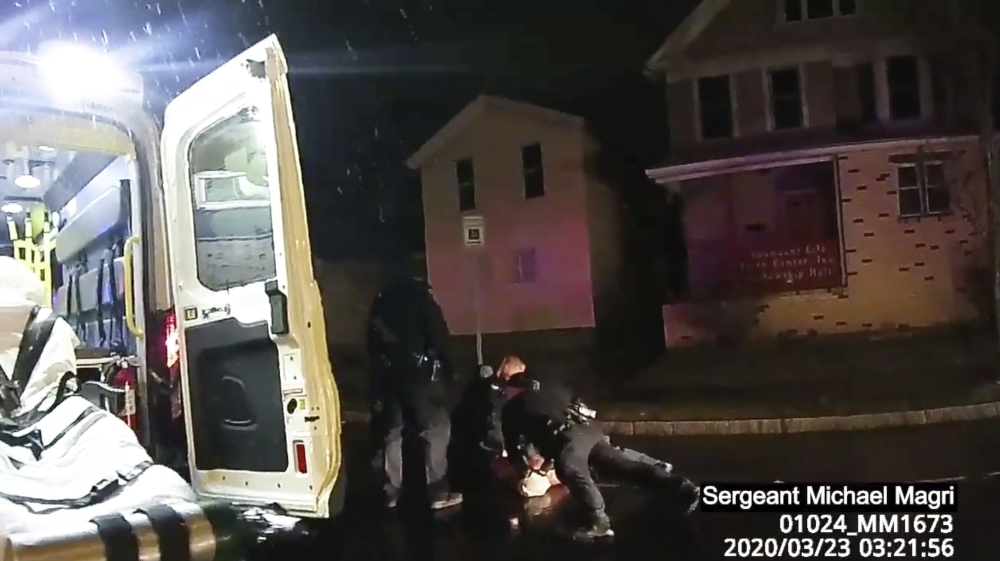US: Police use of spit hoods scrutinised after Black man's death
Daniel Prude’s suffocation raises questions about use of the hoods and reliance on police in mental health crises.
Not five minutes after police in the United States slipped a “spit hood” over Daniel Prude’s head, the 41-year-old Black man went limp. A week later, he was taken off life support.
Prude’s suffocation, in Rochester, New York in March, has drawn new attention to the hoods – mesh bags that have been linked to other deaths – and the frequent reliance on police to respond to mental health emergencies.
His death has underscored one of the top demands of the countrywide movement for police reform: that certain duties should not be handled by law enforcement but by social workers or mental health experts.
Seven officers involved in the incident in Rochester were suspended with pay Thursday.
While many in law enforcement defend the hoods as vital to prevent officers from being spit on or even bitten – a concern that has taken on new importance during the coronavirus pandemic – critics have denounced them as dangerous and inhumane.
For some, they evoke hoods used on prisoners at US government overseas detention sites.
Amnesty International condemned the use of spit hoods Thursday, a day after Prude’s family made public body camera video and police reports it obtained from the Rochester department.
The organisation said the hoods are particularly dangerous when a person is already in distress, as Prude appeared to be.
Police use of spit hoods often “looks like something out of Abu Ghraib”, said Adante Pointer, an Oakland civil rights lawyer who has handled several cases involving the devices, referring to the infamous prison in Iraq.
“They’re often used in a punitive way,” Pointer said.
Just hours before his fatal encounter with police, Prude, who was in Rochester to visit his brother, was taken by police for a mental health evaluation after he was said to have expressed suicidal thoughts.
Prude’s brother told police he was calm when he returned to his house but later got high on PCP and ran away, prompting the brother to call 911.
Police found Prude wandering the street naked after allegedly smashing a storefront window, and he could be seen on body camera footage spitting in the direction of officers and heard claiming to be infected with coronavirus. Officers said that led them to employ the hood.
Prude, handcuffed by this point, can be seen continuing to spit through the mesh and saying that he wanted an officer’s gun. The officers then pinned him to the ground, one of them keeping a knee on his back and another pressing his face into the pavement for two minutes.
Minutes later, an officer could be heard saying, “Ugh, he’s puking”. After realising Prude had stopped breathing, paramedics who had arrived began CPR.
“They put a bag over his head, and they squeezed the air out of him,” said Nicolette Ward, a lawyer for one of Prude’s daughters. “He spent the last moments of his life breathing in his own vomit.”
At a news conference Thursday announcing the police officers’ suspensions, Rochester Mayor Lovely Warren said Prude “was failed by the police department, our mental healthcare system, our society and he was failed by me”.
Prude’s death has raised questions about how authorities respond to mental health emergencies, as well.
Many other deaths at the hands of police have resulted from an encounter that began with a call about someone’s mental health and then devolved.
Nicolette Ward, lawyer for one of Daniel Prude’s daughters
Prude’s death is the second one involving spit hoods to surface since the death of George Floyd at the hands of Minneapolis police sparked a national reckoning on racism and policing. Floyd’s death did not involve a spit hood.
Just three weeks after Prude’s deadly encounter, a similar one happened in Tucson, Arizona.
Police handcuffed and placed a spit hood on the head of a naked man also in distress. Carlos Ingram Lopez died after gasping for air and pleading for water.
In both cases, details about the deaths did not emerge until weeks after.
Source: Read Full Article





